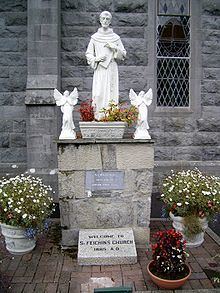Parents Lassair (mother) | Feast day 20 January | |
 | ||
Patronage Fore Abbey, Omey Island, Ardoileán | ||
Saint Féchín or Féichín (died 665), also known as Mo-Ecca, was a 7th-century Irish saint, chiefly remembered as the founder of the monastery at Fore (Fobar), County Westmeath.
Contents
Background
Féchín is said to have been born in Bile, probably Billa in what is now the parish of Ballysadare (Kilvarnet), (Co. Sligo). The medieval Lives call his mother Lassair, identified in the Irish text (first part) as a member of a royal Munster line. The late Irish Life asserts that the saint's foundation at Fore (Co. Westmeath) in Mide was connected to the Luigne and that Féchín himself belonged to the Luigne of Connacht. In the annal for 814, however, the Chronicon Scotorum appears to suggest that the saint's church was connected to both the Gailenga and the Luigne. On the other hand, the Life's claim is corroborated by an entry in the Annals of Ulster (sub anno 993) which styles Máel Finnia, bishop of Fore, bishop of the peoples (túatha) of the Luigne.
The Lives tell us that Féchín received his monastic training from St Nath Í of Achonry and later moved on to Clonmacnoise.
It has been suggested that his name translates as "little raven", consisting of the Old Irish noun fiach "raven" and a diminutive suffix. His name is explained in this manner in a note added to the Félire Óengusso, which says that he received this name when his mother saw him gnawing on a bone and exclaimed "my little raven!" (mo fiachan). The same note also names him Moéca, which is explained as meaning "backslider": when Féchín felt aggrieved over the reward he received for herding the oxen of Ciarán of Clonmacnoise, he left in anger, going eastwards. When he was called back, he refused to return with his face before him and so walked backwards instead, hence the name.
Foundations
The first monastic houses said to have been founded by Féchín are those on the islands of Omey and Ardoilén, both off the coast of Galway, which fell under the protection of the king of Connacht, Guaire Aidne mac Colmáin.
His principal foundation was Fobur, now Fore, Co. Westmeath. Between 771 and 1169, Fore was burned at least twelve times.
Death
According to the Annals of the Four Masters, Féchín died on 14 February in the year 664 [665], during the plague which struck the island at the time. His feast-day is celebrated in Ireland on the 20th of January. A story about Féchín and the plague is found both in the Latin Life of St Gerald of Mayo and in the notes to the hymn Sén Dé (by Colmán of the moccu Clúasaig) in the Liber Hymnorum. It relates that the joint high-kings Diarmait Ruanaid and Blathmac appealed to Féchín and other churchmen, asking them to inflict a terrible plague on the lower classes of society and so decrease their number. Féchín was one of the churchmen to answer their request and to perish in the event, whereas Gerald kept aloof and survived.
One of Féchín's fellow victims in the plague of 665 is said to have been St Rónán mac Beraig (son of Berach), founder of Dromiskin Monastery: Druim Inesclainn, whose relics were enshrined in 801. The Uí Chrítáin, a clerical dynasty who claimed collateral descent from Lóegaire, ruled his house between the mid-9th century and 978, and asserted that their eponymous ancestor Crítán was Rónán's grandfather. The Uí Chrítáin also claimed another five saints as descendants of their line, notably St Columba.
Veneration
Places connected with Féchín's cult include: Fore Abbey (Co. Westmeath), Cong Abbey (Co. Mayo), Omey Island (Co. Galway), Ardoilén/High Island (Co. Galway), Inishmaan (Co. Galway), Claddaghduff (Co. Galway), Cleggan (Co. Galway) and Termonfeckin (Co. Louth). Around 1200 the Norman landlords known as the De Lacys built a Benedictine Priory dedicated to St Féchín and St Taurin.
In Scotland Féchín is venerated in the Latinised form Vigeanus. The village of St Vigeans, near Arbroath in Angus, has a major collection of early medieval sculpture surviving from a monastery dedicated to the saint, perhaps founded in unrecorded circumstances among the Picts in the 8th century.
Other places possibly connected with Féchín in Scotland are Ecclefechan in Dumfriesshire and Torphichen in West Lothian.
Supernatural powers and healing abilities were attributed to Féchín, with holy wells being dedicated to him throughout Ireland, with a concentration of sites in the west. A holy well stands among the remains of his monastic community on Omey Island. A pilgrimage site for those seeking a physical cure for all manner of ailments.
